Political and Economic Challenges
By
TG
A former Secretary of Agriculture once recounted to me. “I was amongst one of the proponents of free trade under WTO. Now no more. Trade liberalization compounded by government neglect of agricultural development were deadly to the farmers, many of whose sons and daughters now dream of going abroad instead of continuing to till the land.”
In the wake of setbacks of WTO – from Seattle in l999 to Cancun in 2003, it seems vital to review some of the deep causes that led to said reverses. The Philippines has joined the group of 20 nations in quest of reforms, perhaps having in mind what former Speaker of the United States said about governance. Let me paraphrase what he wrote, “I have had the privilege of meeting many distinguished prominent personalities, presidents and prime ministers, kings and monarchs, senators and congressmen, of engaging thru the years in national and international public service – but I found that in essence all politics is local.. Attend to the local. Do not take the small man for granted.”
What is the meaning of WTO to the farmer, the fisherman, the entrepreneur? What is ASEAN to them? What of ASEAN plus 3, of ASEM and APEC? What are the political and economic challenges?
Said structures generate meaning as they affect.
1. The farmer who nurtures carageenan in Mindanao seems isolated. He does not know how best to boost production, where and how to sell. He ends up waiting for the buyers’ representative to pick up the produce which he understands will be processed in the Visayas. He lacks information technology, does not know how much value added is lost to him, and cannot even begin to compete for greater access to bigger markets abroad. Should we not integrate local production to local markets even as we seek to integrate our economy with Asia and the world?
2. The projection of benefits from the Agreement on Agriculture in WTO was more trade, more jobs, and more development. Yet the value of exports from farms like coconut products did not show significant progress, were instead swamped by massive imports. The Philippines as a net food importing country became a stark reality, with the agricultural trade balance moving from a surplus of $292 million in l993 to a dismal deficit of $794 in 2002.
3. The proponents of the Agreement on Agriculture foresaw the displacement in the Philippines of many rice and corn growers but claimed that affected farmers could then switch to more viable commercial cash. Yet this is more easily said than done. The economist Kevin Watkins said “The argument that displaced staple producers will simply shift to commercial crops has a surreal quality. High capital costs of entry into commercial food markets and the importance of infrastructures, which is non existent in the more marginal areas from which people will be displaced, means most of the benefits from commercial agriculture to more prosperous producers.”
The suspended WTO meeting for the intended round of review leaves the nations in ferment, bringing into focus the heavy issues that confront the world. We hope that the lessons of the past will eventually bring about a more transparent WTO that truly stands for fair trade.
Meanwhile the direction in our part of Asia points to ASEAN not only accelerating its Free Trade Area or expanding the ASEAN plus 3 dialogues meaning vis-à-vis China, Japan, South Korea. In January 2002 ASEAN signed an Agreement for Close Economic Partnership with Japan. In November 2004 ASEAN signed a Free Trade Agreement with China. At the last ministerial meeting of ASEAN, Malaysian Foreign Minister announced that the first East Asian Summit would be held in Malaysia in December 2005 and that invitations would be extended to the ASEAN countries, as well as China, Japan, South Korea, India, Australia and New Zealand – but not the United States.
In the wake of these developments – what are the political and economic challenges that we face? The political often blends with the economic – but not always –for nations still look to their national interests and strategic values they hope to reap from their acts.
When Prime Minister Mahatir during his term first proposed a Summit in Asia amongst Asians, the US countered with the formation of APEC, believing that strategic concerns demanded her presence in any such vital undertaking.
Today the Asian Summit becomes reality in December. It can have a life of its own, can take up issues other than trade and investments, can resolve to grow and tackle poverty more resolutely.
What will the US do? What are her concerns? Taiwan? Safe passage for merchant ships in sea lanes in the South China Seas? Terrorism? To label who are terrorists, who are not? The power to implement a preemptive strike? Such concerns seem far fetched at this time, and just as the US has successfully initiated a number of regional organizations in the past like NAFTA without intervention from others, perhaps the US could in turn endorse a move amongst Asians to determine their own destiny.
The East Asian Summit comes in the wake of the ASEAN Chinese Free Trade Agreement. Tough negotiations lie ahead with a targeted time frame of l0 years to complete. ASEAN is the hub in ASEAN plus China, Japan, South Korea dialogues. Although there exist deep animosities between China and South Korea and Japan, ASEAN is the forum where the three find common ground of friendly neutrality, where they can exchange ideas, and lessen biases – which may pave the way for a bigger East Asia Free Trade Area. An ASEAN experts group has concluded that by 2020 an ASEAN Japan economic partnership will increase ASEAN’s export to Japan by44.2 percent and Japanese exports to Southeast Asia by 27.5 percent, compared to l997. A similar study y Chinese and ASEAN academic experts showed that the ASEAN Chinese Free Trade Agreement will result result in a 48percent exports to China and would increase China’s GDP by 0.33 percent. Great. But the devil is in the details and ASEAN must do its homework.
Furthermore China has openly committed to help developing nations, like those in ASEAN. Let me quote Mr. Eng Chuan Ong from the ministry of Foreign Affairs in Singapore. “China has explicitly stated that it wants to help protect developing nation interest in WTO. Its leadership has called for the creation of an international multilateral trading system in which developing countries are ensured unimpeded and indiscriminate access to the international market for their products and goods. Nicholas Lardy, a china scholar, predicted that china, as it gained ground in the organization, would demand changes in the informal governance structures that have previously allowed the developed economies to shape the WTO’s agenda. More concretely, a report published by the International Monetary Fund (IMF) assesses that China is likely to press for reform of WTO antidumping rules, to guard against attempts to use labor and environmental issues as disguises for protectionism, and possibly to push for a reduction of agricultural subsidies.”
The developing countries would logically welcome such support.
In sum - 1. ASEAN by itself seeks to expand economic ties with China, Japan South Korea, including an East Asian Summit. This is the alternative to WTO while developing nations await more transparency and reforms in the WTO.
2. Said transparency and reforms are politically and economically beneficial not only to third world countries but to developed nations as well, and just as a house divided cannot stand a world starkly riven between rich and poor nations cannot long endure.
3. The political flashpoints in Asia are Taiwan and North Korea but time and understanding of the basic issues are peacefully resolving themselves. The battle against terrorism will be won as poverty diminishes, as justice becomes more prevalent in organized institutions.
4. ASEAN faces a big challenge. In the Philippines for example we must resolutely implement information technology at all levels and assiduously prepare for the parameters of trade and investment - for the true wealth of the nation is not only in human capacity that we harness but also in the natural resources we tap and give value added to.

JULY 4, 2008
VIDEO CLIP- VPTG SPEECH AT CENPEG'S CONFEST
MESSAGE BOARD
> New Video Presentation. Pictures taken during the launching.
>The "Fight for the Filipino" Book Launching was a huge success. Thanks to all your support!
> The book will be available in National Book Store. you may place your order thru their website. www.nationalbookstore.com
>The Academic Publishing Co. also accepts order and they deliver. Call 9125966. Look for Ms. Lani.
FIGHT FOR THE FILIPINO!
an autobigraphy of Tito Guingona
>The "Fight for the Filipino" Book Launching was a huge success. Thanks to all your support!
> The book will be available in National Book Store. you may place your order thru their website. www.nationalbookstore.com
>The Academic Publishing Co. also accepts order and they deliver. Call 9125966. Look for Ms. Lani.
FIGHT FOR THE FILIPINO!
an autobigraphy of Tito Guingona
VIDEO PRESENTATION
Book Review on "Fight for the Filipino"
Patriot and Activist
By
Carmen Guerrero Nakpil
Only a man “with soul so dead”, wrote the English poet, does not love his native land. All of us claim to love our country. But few love it and its people with the passionate activism and militancy of Teofisto Guingona, Jr. His autobiography, “Fight for the Filipino” is a treatise on patriotism.
In different form and roles, Tito Guingona has been a constant presence in our national life. At different times, he has been a member of the 1971 Constitutional Convention, Chairman of the Commission on Audit, member of the Philippine Senate, Executive Secretary and Secretary of both of Foreign Affairs and of Justice, Vice President of the Republic and Ambassador to the People’s Republic of China. But those are only his formal titles. And, outside of our knowledge of civics and government positions, they tell us very little about Tito Guingona’s total commitment or emotional dynamism. For instance, it is only the last chapter of his 346-page biography that we learn of his latest entitlement to a charge of rebellion earned one afternoon, at the Manila Peninsula Hotel, where he was tear-gassed, arrested, handcuffed and detained.
His saga of fighting for the Filipino begins when he was a 12-year old boy who tagged along on the historic trek taken by President Quezon, his family and some members of his family, including Tito’s father, Commissioner for Mindanao and Sulu, Guingona from Northern Lanao to Bukidnon on the way to Australia in 1942.
It runs through, in vivid detail, through his years as a young student and a neophyte lawyer’s advocacy against the Parity Agreement and the U.S. Military Bases; through his stint in the making of the 1973 Constitution with concomitant arrest and detention during Martial Law; his colorful experiences with Mindanao and Manila partisan politics; his travails and policy differences in the cabinet; his frequent denunciations of anti-Filipino policies and projects; and lastly, his denunciation of a sitting President which caused a regime change.
But I must allow the readers of “Fight for the Filipino”, to discover for themselves the intriguing bits of Philippine history that Tito Guingona describes in the fast-paced, candid, conversational prose of his memoirs. For instance, the incident that happened, only four days after Gloria Arroyo’s take over of Malacañang in 2001, when the new Secretary of Justice, Hernando Perez, whispered in his ear in Tagalog, “She phoned me at midnight to order me to sign the IMPSA contract.” (an anomalous Argentinean contract which President Joseph Estrada had refused to sign because of its sovereign guarantee clause)
There are many other anecdotes and vignettes in this autobiography which makes it, more than intimate personal history, a history of the Philippines and a record of the events and personages of the last 80 years. It is also a manual for the younger generations on how to honor, love and defend this country and its people. There are few better teachers of patriotism than Teofisto (Tito) Guingona, Jr.
Story-telling – the Guingona Way
by
Eggie Apostol
Teofisto Guingona, Jr., one-time Vice-President of the Philippines has many stories to tell. And he tells them in great detail in his book “Fight for the Filipinos”
The stories are so highly detailed that one suspects Tito Guingona keeps a diary. Does he? I have not been able to ask him.
If he doesn’t, then we can only say he has a fantastic memory. And it is just as well for the telling of his life is like a recollection of our nation’s history.
Focus is, of course, on Mindanao – where his own father like him served as senator and later Commissioner for Mindanao and Sulu.
For those who lived all their lives in Luzon (or in the Visayas for that matter) the goings-on in Mindanao are like happenings in a foreign country. Because the country is mostly Christian but Mindanao has a sizeable number of Muslims (nine thousand about 50 years ago) mostly due to its proximity to Borneo and Indonesia.
One cannot help but envy the Guingona family for growing-up in the most beautiful part of the country – the Lake Lanao area.
This was so beautiful that when President Quezon saw it he asked that a branch of the Manila Hotel be built there. Which was done.
Although his family was anchored in Mindanao, Guingona studied in the Ateneo de Manila so that later in life he hobnobbed with Raul Manglapus, Diosdado Macapagal, Joe Calderon and Caesar Espiritu, Carlos Garcia and Jun Puyat. When problems came up about the Mindanao area he was always the Mindanao expert for solutions.
Guingona relates during Marcos’ martial rule:”one evening over a secretive dinner, where Fathers Horacio de la Costa and Jaime Bulatao were present, one of our conservative members of the group said: “The real response to martial rule is rebellion, but I’d like to know from our religious Fathers here – whether rebellion is morally justified?” The question was a riser; it was not said in a jest, and one of the priests curtly replied “Don’t worry, we’ll find a way to justify it.” That broke the ice and resulted in laughter.
Guingona’s life had its share of ironies. Before EDSA I he joined Cory in boycotting products linked to Malacañan, “I challenge the crowd not to pay their Meralco bill. Seven days later after our victory with Cory she appointed me president of Meralco. So I called for another big meeting and told the people ”Times have changed – pay your Meralco bills!”
Guingona liked to encourage better relations with Chinese in the Philippines. He submitted some suggestions: 1) Enhance herbal medicine in the Philippines, with Chinese help 2) Plant cassava or cash crops between spaces of coconut trees. 3) generates jobs by adopting the policy of giving value added to native products 4) Encourage technology connected to giving added value to coconut, fruits and fish; 5) encourage tourism by building necessary infrastructures 6) implement joint economic ventures.
Readers will be reminded that Guingona was a political activist from the start. When he was made Chairman of the Commission on Audit he was also a peace negotiator. When President Ramos made him executive secretary he grappled with the ADC and Jai Alai and the Flor Contemplacion case. He actively joined the fight for justice in the Vizconde massacre, the Jalosjos case, the Fr. Shay Cullen problem, the Maysilo Estate case, the Alfredo Tiongco case, U.S. property claim in Fort Bonifacio, the Textbook scam, the Visiting Forces Agreement, the WTO and GATT.
As Vice-President and Secretary of Foreign Affairs he was involved in 9/11 and the VFA, the IMPSA controversy, concern for the OFW’s and attending to foreign travel commitments. He differed with Malacañang in in pursuing OFW and Steel mill programs. He said No to Bush’s war in Iraq.
At book’s end, Guingona is very much in a negative mode: He sees in the Gloria Arroyo regime much that he finds dishonest. He had been asked by President Arroyo to become the new Ambassador to China which he accepted.
But the “Hello Garci” tapes was unraveled and proved that President Arroyo had tampered with the elections. Guingona did not want to continue with his new assignment and resigned.
“We must reform” is his current and latest plan.
INVITATION
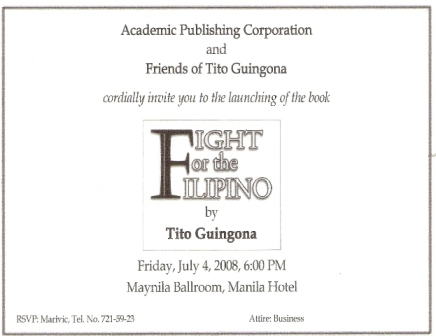
BOOK

Pls. call us for resevation.
BOOKS
THE GALLANT FILIPINO
A nation is poorer by so much everytime one of its heroes passes into oblivion. For as Tito Guingona, Jr. writes "the true treasures of the Filipino are not gold or silver" They are the men and women whose heroic lives would bring back to us in a book. And so Tito Guingona has written The Gallant Filipino...
LABAN - VOICE OF RESISTANCE
On Sept. 21, 1972 Ferdinand E. Marcos imposed martial rule in the Philippines. It marked the beginning of a black chapter in the nation's story. On Aug. 21, 1983 they killed Benigno S. Aquino. His death inflamed the nation, and it marked the beginning of the end for Mr. Marcos. From then on the people demanded back their rights. they rallied. they marched. They defied the guns and tanks and bullets of the dictator - in the end, they defended the soldiers who rose in revolution. In that crucial hour, the nation triumphed...
FACE THE CHALLENGE
To the small Filipino businessman - whose continuing strife to survive deserves sustained support. May he eventually succeed - if not under the present economic system - then in another more responsive to the nation's needs!
A nation is poorer by so much everytime one of its heroes passes into oblivion. For as Tito Guingona, Jr. writes "the true treasures of the Filipino are not gold or silver" They are the men and women whose heroic lives would bring back to us in a book. And so Tito Guingona has written The Gallant Filipino...
LABAN - VOICE OF RESISTANCE
On Sept. 21, 1972 Ferdinand E. Marcos imposed martial rule in the Philippines. It marked the beginning of a black chapter in the nation's story. On Aug. 21, 1983 they killed Benigno S. Aquino. His death inflamed the nation, and it marked the beginning of the end for Mr. Marcos. From then on the people demanded back their rights. they rallied. they marched. They defied the guns and tanks and bullets of the dictator - in the end, they defended the soldiers who rose in revolution. In that crucial hour, the nation triumphed...
FACE THE CHALLENGE
To the small Filipino businessman - whose continuing strife to survive deserves sustained support. May he eventually succeed - if not under the present economic system - then in another more responsive to the nation's needs!
Vice President
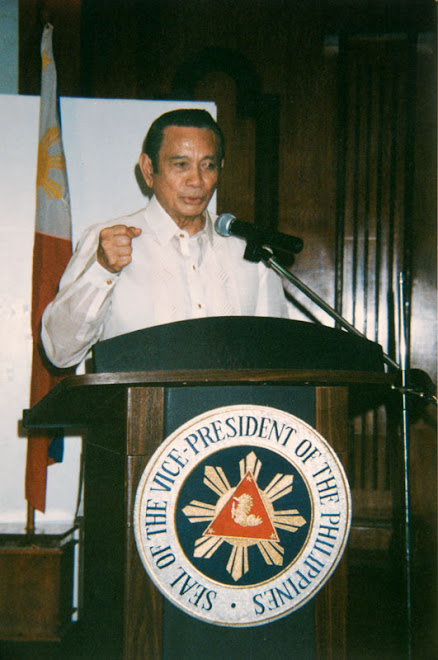
Tito Profile
Teofisto T. Guingona, Jr. reached a new high in his stellar career when both Houses of Congress confirmed his nomination as Vice President of the Philippines by President Gloria Macapagal Arroyo.
Born in San Juan, Rizal on July 4, 1928 to Teofisto Guingona, Sr., a former assemblyman, senator, judge and commissioner from Guimaras, Iloilo and Josefa Tayko of Siaton, Negros Oriental, he grew up in Mindanao where he completed his elementary schooling with honors in Ateneo de Cagayan.
He pursued his studies at the Ateneo de Manila University as a working student, teaching history and political science while taking up courses in law and economics. He took up special studies in Public Administration, Economics, Sociology and Audit. After graduation, Tito went into business and became a Governor of the Development Bank of the Philippines and President of the Chamber of Commerce of the Philippines.
Tito was a delegate to the 1971 Constitutional Convention and when Martial Law was declared in 1972, he staunchly resisted the abuses of the regime, serving as a human rights lawyer and defender of the oppressed. He founded SANDATA and became the honorary chairman of BANDILA, two mass-based organizations dedicated to social and economic reforms. Because of his opposition to martial rule he was jailed twice, first in 1972 and then in 1978.
When the dictator was ousted, the new President appointed Tito as Chairman of the Commission on Audit where he gained renown as a no-nonsense graft buster. He did not stay long in the Commission on Audit, however, for he was drafted to run for a Senate seat. In the Senate, Tito was Senate President Pro-tempore and Majority Leader. He also chaired the Blue Ribbon Committee.
Tito’s concern for the welfare of his kababayans in Mindanao is apparent when he served as director and chairman of the Mindanao Development Authority and the Mindanao Labor Management Advisory Council respectively.
Born in San Juan, Rizal on July 4, 1928 to Teofisto Guingona, Sr., a former assemblyman, senator, judge and commissioner from Guimaras, Iloilo and Josefa Tayko of Siaton, Negros Oriental, he grew up in Mindanao where he completed his elementary schooling with honors in Ateneo de Cagayan.
He pursued his studies at the Ateneo de Manila University as a working student, teaching history and political science while taking up courses in law and economics. He took up special studies in Public Administration, Economics, Sociology and Audit. After graduation, Tito went into business and became a Governor of the Development Bank of the Philippines and President of the Chamber of Commerce of the Philippines.
Tito was a delegate to the 1971 Constitutional Convention and when Martial Law was declared in 1972, he staunchly resisted the abuses of the regime, serving as a human rights lawyer and defender of the oppressed. He founded SANDATA and became the honorary chairman of BANDILA, two mass-based organizations dedicated to social and economic reforms. Because of his opposition to martial rule he was jailed twice, first in 1972 and then in 1978.
When the dictator was ousted, the new President appointed Tito as Chairman of the Commission on Audit where he gained renown as a no-nonsense graft buster. He did not stay long in the Commission on Audit, however, for he was drafted to run for a Senate seat. In the Senate, Tito was Senate President Pro-tempore and Majority Leader. He also chaired the Blue Ribbon Committee.
Tito’s concern for the welfare of his kababayans in Mindanao is apparent when he served as director and chairman of the Mindanao Development Authority and the Mindanao Labor Management Advisory Council respectively.

the senator at work
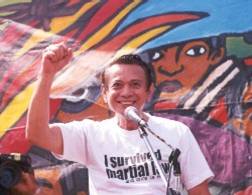
i survived martial law
Anti GMA Rally
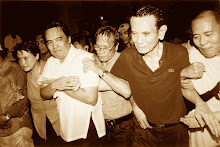
Water Canonized by the Police
About the Peninsula Seige/ An Interview with Karen Davila
Friday, April 18, 2008
Subscribe to:
Post Comments (Atom)



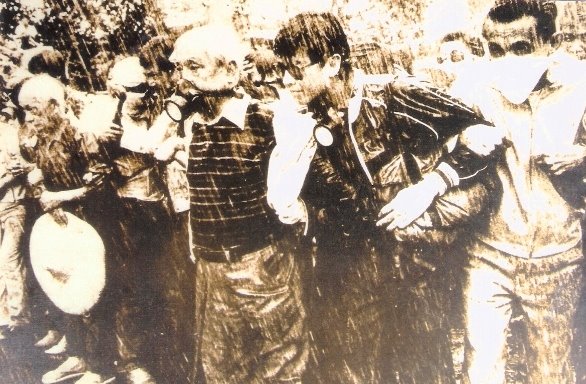

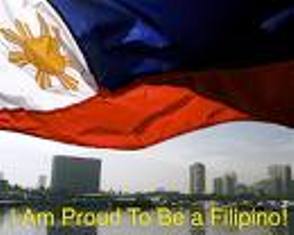
No comments:
Post a Comment